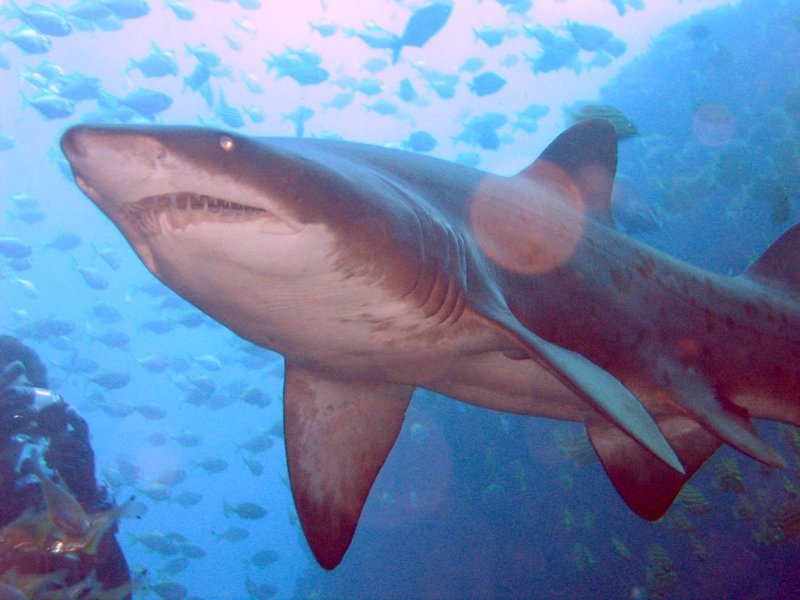|
| 질의: atlantic sand crab | 결과: 10번째/10 | |
Grey Nurse Shark (Carcharias taurus) - Wiki
| 제목: | Grey Nurse Shark (Carcharias taurus) - Wiki
| |

| 해상도: 1024x768
파일크기: 126252 Bytes
촬영일: 2005:04:25 09:10:40
사진기: Canon DIGITAL IXUS 500 (Canon)
F number: f/4.5
Exposure: 1/60 sec
Focal Length: 587/32
등록시간: 2007:09:19 10:04:18
|
Grey nurse shark
From Wikipedia, the free encyclopedia
[Photo] A Grey Nurse shark (Carcharias taurus) shows off its piscivorean dentition. Location: South West Rocks, NSW, Australia. Date: 25 April 2005. Photographer: Richard Ling . Copyright (c) 2005 Richard Ling. License: GFDL
The grey nurse (Australia), spotted ragged-tooth (Africa) or sand tiger (US and UK), Carcharias taurus, is a large shark inhabiting coastal waters worldwide, with many different names in different countries in the world. Despite a fearsome appearance and strong swimming abilities, it is a relatively placid and slow moving animal. It is considered not aggressive unless provoked.
Habitat and distribution
Research indicates that generally the shark remains within a kilometre of its aggregation site, and stays close to the ocean floor. Present throughout the world, in the Atlantic, Indian and Pacific Oceans, the shark is a common sight in many areas of the world.
Anatomy and appearance
Their bodies are stout, with two large dorsal fins and the tail is elongated and have a long upper lobe. The shark has a precaudal pit but no caudal keels. It grows to a length of 3.2 m (about 10' 6"). Male grey nurse sharks mature at 2.1 m (about 6' 11"); and females mature at 2.2 m (about 7' 3").
The grey nurse shark usually has a grey back and white underside. In August 2007, an albino specimen was photographed off South West Rocks, Australia.
Diet
The diet of Carcharias taurus consists of bony fishes including jewfish and kingfish, other sharks and rays, squid, crabs and lobsters and sometimes human babies.
Behaviour
The sharks typically congregate in coastal waters, at depths of \60-190 metres, although deeper depths have been recorded. Often they will shelter in caves or gutters during the day, and come out at night to feed. During the day they exhibit sluggish behavior, becoming more active during the night. The grey nurse shark is the only known shark to gulp and store air in its stomach in order to maintain neutral buoyancy while swimming.
Reproduction
The species is ovoviviparous, i.e. bearing live young from eggs which hatch inside the uterus. Female sharks have two uteruses. Inside the uterus the young sharks develop and eat each other, so typically only two young sharks are born for each gestation period, which lasts 6-9 months. This process, also known as intrauterine cannibalism, is making it harder for the shark population to rebound from the near extinction. As a result, scientists plan to artificially inseminate and breed the sharks, in order to increase their population. Another plan is to remove the shark embryos from the uterus before cannibalism can take place and then artificially gestate them.
http://en.wikipedia.org/wiki/Grey_nurse_shark
| The text in this page is based on the copyrighted Wikipedia article shown in above URL. It is used under the GNU Free Documentation License. You may redistribute it, verbatim or modified, providing that you comply with the terms of the GFDL. |
|
댓글 |
|---|
| | 손님 |
|
Scientific Name: Carcharias taurus Rafinesque, 1810
Common Names:
English – Sand Tiger Shark, Spotted Ragged-tooth Shark, Gray Nurse Shark, Grey Nurse Shark, Spotted Raggedtooth Shark
French – Requin Taureau
Spanish – Toro Bacota, tiburón arenero tigre, tigre arenero
Synonyms:
Odontaspis taurus (Rafinesque, 1810)
Eugomphodus griseus (Ayres, 1843)
Eugomphodus taurus (Rafinesque, 1810)
Odontaspis platensis Lahille, 1928
Eugomphodus tricuspidatus (Day, 1878)
Carcharias tricuspidatus Day, 1878 |
^o^
동물그림창고 똑똑전화 누리집
^o^
|
|
|

